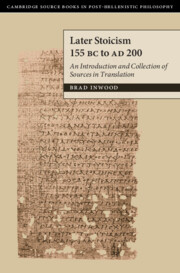Book contents
- Later Stoicism 155 BC to AD 200
- Cambridge Source Books in Post-Hellenistic Philosophy
- Later Stoicism 155 BC to AD 200
- Copyright page
- Dedication
- Contents
- Acknowledgements
- Abbreviations
- Introduction
- Chapter 1 The First Hundred Years
- Chapter 2 Posidonius
- Chapter 3 From Posidonius to Seneca
- Chapter 4 Seneca the Younger
- Chapter 5 Epictetus
- Chapter 6 The Second Century ce
- Concordance
- Bibliography
- Index of Sources
- General Index
- References
Bibliography
Published online by Cambridge University Press: 30 April 2022
- Later Stoicism 155 BC to AD 200
- Cambridge Source Books in Post-Hellenistic Philosophy
- Later Stoicism 155 BC to AD 200
- Copyright page
- Dedication
- Contents
- Acknowledgements
- Abbreviations
- Introduction
- Chapter 1 The First Hundred Years
- Chapter 2 Posidonius
- Chapter 3 From Posidonius to Seneca
- Chapter 4 Seneca the Younger
- Chapter 5 Epictetus
- Chapter 6 The Second Century ce
- Concordance
- Bibliography
- Index of Sources
- General Index
- References
- Type
- Chapter
- Information
- Later Stoicism 155 BC to AD 200An Introduction and Collection of Sources in Translation, pp. 557 - 563Publisher: Cambridge University PressPrint publication year: 2022



